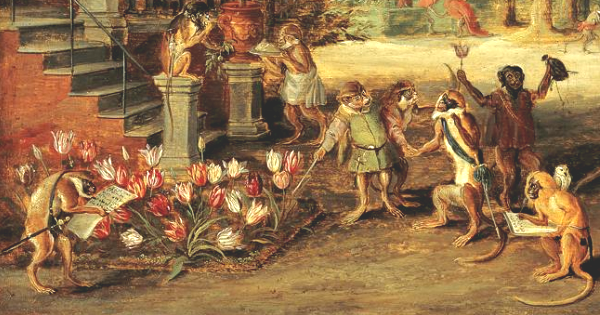
The tulip mania that occurred in the Netherlands during the 1630s is considered to be the first recorded instance of a market bubble.
“[BitCoin] reminds me of the Tulip mania in Holland in the 1640s, and so the question is did that collapse? We still pay for tulips even now and sometimes they get expensive.“ Robert Shiller, Yale economist and Nobel Prize laureate
As has been the case of other market bubbles, the tulip mania constituted a relatively short period of rapid increase in prices, unsubstantiated by any corresponding increase in intrinsic value, followed by a burst, whereby the prices dropped to practically zero. The mania’s roots were in the Netherlands’ Golden Age, a period of prosperity stemming from overseas trading. The newly introduced tulips became a coveted status symbol, and buyers sought rarer and rarer varieties even as their prices increased (an example of Veblen goods). Speculators traded tulip bulbs as well as futures on the bulbs. Eventually, the trading was done almost entirely through contracts without the bulbs actually changing hands. Tulip prices suddenly plummeted in February 1637, without the obligations under the contracts actually being exercised. Even though in modern times the tulip mania has sometimes been presented as a catastrophe, and indeed many later market bubbles have been likened to the tulip mania, only a small number of people were involved in the bubble and suffered any losses. It also did not have a substantial impact on the Dutch economy or its dominance, which lasted to the end of the century.
Tulipánová horečka, ke které došlo v Nizozemí v 30. letech 17. století, je považována za první doložený příklad tržní bubliny.
„[BitCoin] mi připomíná tulipánovou horečku v Holandsku v 40. letech 17. století, a otázkou je, opravdu došlo ke kolapsu? I dnes platíme za tulipány, a někdy jsou i drahé.“ Robert Shiller, ekonom z Yale a laureát Nobelovy ceny
Jako tomu bylo i v případě ostatních tržních bublin, tulipánová horečka představovala relativně krátké období rychlého vzestupu cen, který nebyl podložen odpovídajícím nárůstem vnitřní hodnoty, následované prasknutím, ve kterém ceny klesly prakticky na nulu. Kořeny této horečky byly ve Zlatém věku Nizozemí, což bylo období prosperity založené na zámořském obchodování. Nově dovezené tulipány se staly vyhledávaným symbolem statutu, a kupující vyhledávali vzácnější a vzácnější odrůdy s tím, jak se cena zvyšovala (tedy příklad Veblenovského zboží). Spekulanti obchodovali s tulipánovými cibulkami i s futures těchto cibulek. Nakonec se obchodování dělo takřka výhradně přes smlouvy, aniž by cibulky vůbec byly předány z ruky do ruky. Ceny tulipánů nakonec náhle spadly v únoru 1637, aniž by povinnosti ze smluv byly skutečně realizovány. Ačkoli se v moderní době tulipánová horečka prezentuje jako katastrofa, a spousta pozdějších tržních bublin byla k tulipánové horečce připodobňována, jen malé množství lidí se na této bublině se podílelo a utrpělo ztráty. Také neměla podstatný vliv na nizozemskou ekonomiku nebo její dominanci, která přetrvala do konce století.
English Editorial Services’ mission is to assist international businesses and organizations of all sizes to communicate clearly, correctly, and persuasively with their business partners and target audiences.
Simply subscribe to receive our Business Term of the Day at no charge to your inbox each business day, with explanation in English and Czech.



English Editorial Services’ mission is to assist international businesses and organizations of all sizes to communicate clearly, correctly, and persuasively with their business partners and target audiences.
Simply subscribe to receive our Business Term of the Day at no charge to your inbox each business day, with explanation in English and Czech.

